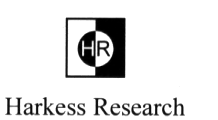
 Wisp Unification
Theory - 8 Wisp and Special Relativity: Electrodynamics
Wisp Unification
Theory - 8 Wisp and Special Relativity: Electrodynamics
- Home
- About Me
- Reasons why Einstein was wrong
- One-way speed of light experiments
- Hot topic
- Q&A
- ACES - The end of Relativity
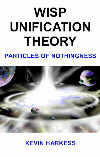
- Book Contents
- Introduction
- 1 Matter,Space and Time
- 2 Symmetry
- 3 Fractals
- 4 Wisp Space
- 5 Gravity
- 6 Electromagnetic Force
- 7 Wisp & S.R: Fundamentals
- 8 Wisp & S.R: Electrodynamics
- 9 Wisp & S.R: Doppler effect
- 10 Wisp & S.R: Relativistic Mechanics
- 11 Big bang
- Appendix A
- Appendix B
- Index A-Z
- Copyright
- Feedback
This page contains the complete chapter. To download the new 2011 2nd edition of wisp unification theory go to the homepage.
8
Wisp and Special Relativity: Electrodynamics
8.1 Electrodynamics of moving bodies
Inertial reference frames that move through wisp space do so with respect
to absolute frames in which the wisps are stationary. And so we cannot
simply switch between stationary and moving frames and expect all laws
of physics to be the same.
For example, in stationary frame S an electron moves and generates a magnetic
field by rotating its electric field pattern in the surrounding wisp space.
So we know that the physical effect of pattern rotation does occur in
wisp space.
Now consider yourself moving with the electron (frame S’). From a
purely relativistic viewpoint, special relativity would argue that because
the electron is stationary in frame S’ no magnetic field exists,
and any force that results must be purely electrostatic in origin. Indeed,
Einstein successfully used this argument in special relativity to explain
the Lorentz force law. But here, the two frames differ only by a uniform
linear boost – linear velocity translation – and so we cannot
simply say that patterns in wisp space have stopped rotating.
However, we can show that relativistic effects in moving frames can make
some physical laws behave in ways that are indistinguishable from those
in an absolute rest frame.
First we look at the total electromagnetic force F acting on a
charge q, with velocity v, moving in electric and magnetic
fields E and B, as given by the Lorentz force law
![]()
8.2 Force measurements in different frames
We will calculate the electromagnetic force exerted on a particle with
charge -q by electrons moving in a wire.
The force will be calculated by stationary and moving observers, first
with the wire at rest in absolute wisp space, and then with the wire and
observer moving.
Results will show that the magnitude of the force is the same in all reference
frames, regardless of whether the wire is moving or stationary in wisp
space.
Twentieth-century scientists thought that the properties of ether could
not produce equal forces in all frames and so could not support the Lorentz
force law. Einstein held this view when he developed special relativity.
But it is not necessary to dismiss the concept of ether to explain the
Lorentz force law. As we will now discover, wisp theory shows that the
effects of the force are the same in all reference frames.
8.2.1 Electromagnetic force in absolute frame S
A wire at rest in absolute frame S carries a current of electrons, which
generate a rotating magnetic field B (Figure 8.1).
The wire has no electrostatic surface charge, because positive ions within
the wire neutralize the negative charge on the moving electrons.
A charge -q moves parallel to the wire in the direction of the
electron current, and experiences an attractive force F.

Equation set 8.1 shows the equations for calculating the magnitude of
the magnetic force. Calculations show that the wire’s magnetic field
attracts the moving negative charge towards it.
Since the wire is electrically neutral it experiences no electric force
and the force of attraction must be solely magnetic. The measurements
made are absolute because the wire and observer are stationary in wisp
space, and so the effect of time dilation is absent.
8.2.2 Electromagnetic force in moving frame S’
Now consider the same events as seen by an observer moving with the charged
particle (frame S'). In this frame the electrons and the charged particle
appear ‘at rest’. So we will hypothesize that the charged particle
does not experience any magnetic force, since it is ‘at rest’
(Figure 8.2). (In reality magnetic fields are still present, although
to the moving observer in frame S' they would go undetected.)
The purpose of this example is to demonstrate – from wisp theory’s
viewpoint – how Einstein came to discover that the electric and magnetic
effects are the same thing, but appear different to observers in relative
motion. What one observer considers electric another may consider magnetic,
and vice versa.
But even though the observer in frame S’ does not detect a magnetic
effect, nevertheless it is still present (pattern rotations through wisp
space cannot simply be cancelled out through relative concepts), and manifests
itself as a change in electric charge. Equation set 8.2 shows the calculations
used to measure the magnitude of the relative electric force in frame
S’.
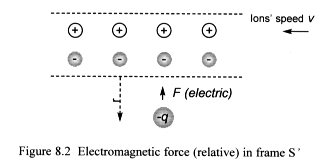
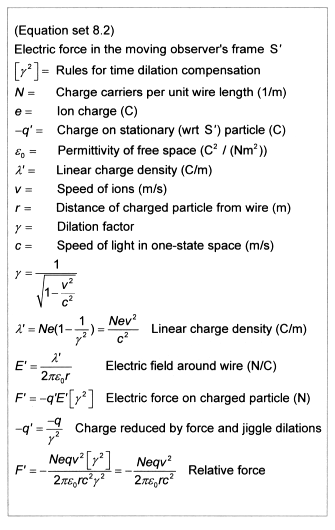
The positive ions are now in ‘motion’ with respect to the ‘stationary’
electrons. In reality the effects of force and jiggle dilations are present,
which reduce all negative charges by gamma squared. And the positive ions
are really at rest in absolute wisp space and so remain at full strength.
This produces the charge strength term (1-1/gamma^2) in the linear charge
density equation.
We first expressed the moving observer’s force in absolute terms,
and then applied the rules for time dilation compensation, which
convert the absolute measurements into relative ones (moving observers’
measurements are always relative).
The calculations show that the wire acquires a net positive electrostatic
charge, which acts on the charged particle.
All things being taken into account, we find that a force originating
from a magnetic field in one frame compares equally to an electric force
in another frame (Equation set 8.3).
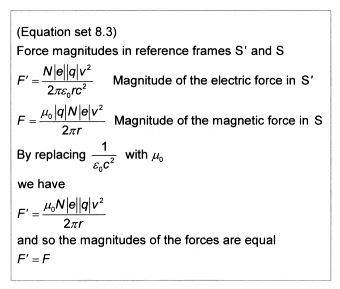
Earlier I stated that you cannot simple switch between frames that are
absolute and ones that move, and expect there to be no physical changes.
In this instance physical changes have taken place – the effectiveness
of the negative charges have been reduced by the force and jiggle dilations.
However, the moving observer is unaware of any changes as the application
of time dilation compensation masks them.
Only by knowing their absolute motions through wisp space can observers
determine the true effects of force, jiggle, and time dilations. But even
with this knowledge, they will not notice the dilation effects and will
measure identical forces in all inertial frames.
However, tests will soon be able to demonstrate the existence of motion
through wisp space.
Finally, we calculate the magnitude of the force when both the wire and
the observer are moving through wisp space. The dilation effects will
be more complex, but the magnitude of the force measured by the observer
will be the same as if the wire were stationary.
8.2.3 Electric force on wire moving through wisp space
The wire moves through wisp space at absolute speed Vw.
The positive ions, electrons and the negatively charged particle all have
their speeds equally increased.
An observer moves with the negative charges (frame S’’). We
hypothesize that the effect of the magnetic force in this frame is zero.
Equation set 8.4 shows the equations for calculating the magnitude of
the electric force.
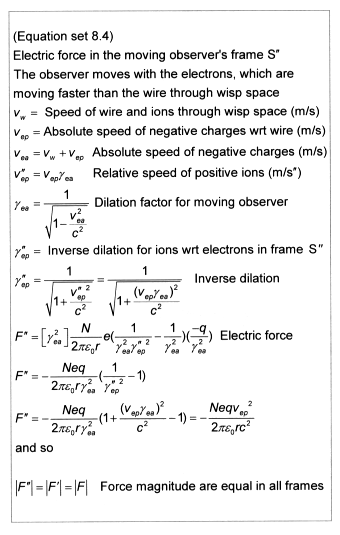
The effects of force and jiggle dilations apply to all moving charges,
but because the positive ions are moving slower than the electrons through
wisp space, their dilation effects are smaller.
All charges reduce by (gamma)ea squared because
of the effects of force and jiggle dilations. But because the positive
ions move slower we must compensate their dilation effects. By dividing
their charge by the inverse dilation (gamma”ep
squared) we increase their effective charge strength.
We multiply the whole equation by (gamma)ea squared
(rules for time dilation compensation).
After time dilation compensation is taken into account, we find that the
magnitude of the force of attraction between the moving negatively charged
particle and the wire is the same as that found earlier in frames S’
and S.
8.3 Ether re-established
We have proven that all observers measure electromagnetic forces as having
the same magnitude in all inertial frames, and so wisp theory proves that
the Lorentz force law is valid in an ether medium – wisp space. And
so it is not necessary to use Einstein’s concepts of space–time
to explain this.
There can be no doubt that the ether is responsible for the effects of
the electromagnetic force, and since the force is the same in all frames,
Lorentz symmetry - also known as observer Lorentz invariance -
is supported in an ether flow.
Home --
About Me -- Reasons
why Einstein was wrong -- One-way
speed of light experiments -- Hot
topic --
Q&A -- ACES
- The end of Relativity --
Book Contents -- Introduction
-- 1 Matter,
Space and Time -- 2
Symmetry -- 3
Fractals -- 4 Wisp Space
-- 5 Gravity -- 6
Electromagnetic Force --
7 Wisp & S.R: Fundamentals
-- 8 Wisp & S.R: Electrodynamics --
9 Wisp
& S.R: Doppler effect -- 10
Wisp & S.R: Relativistic Mechanics --
11 Big bang -- Appendix
A -- Appendix B -- Index
A-Z -- Copyright -- Feedback